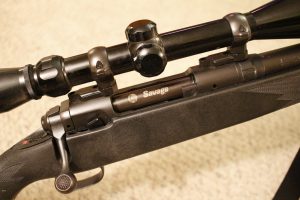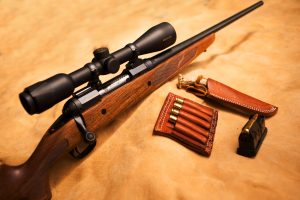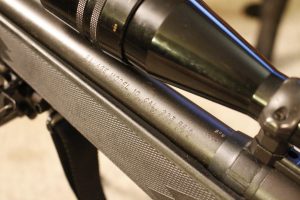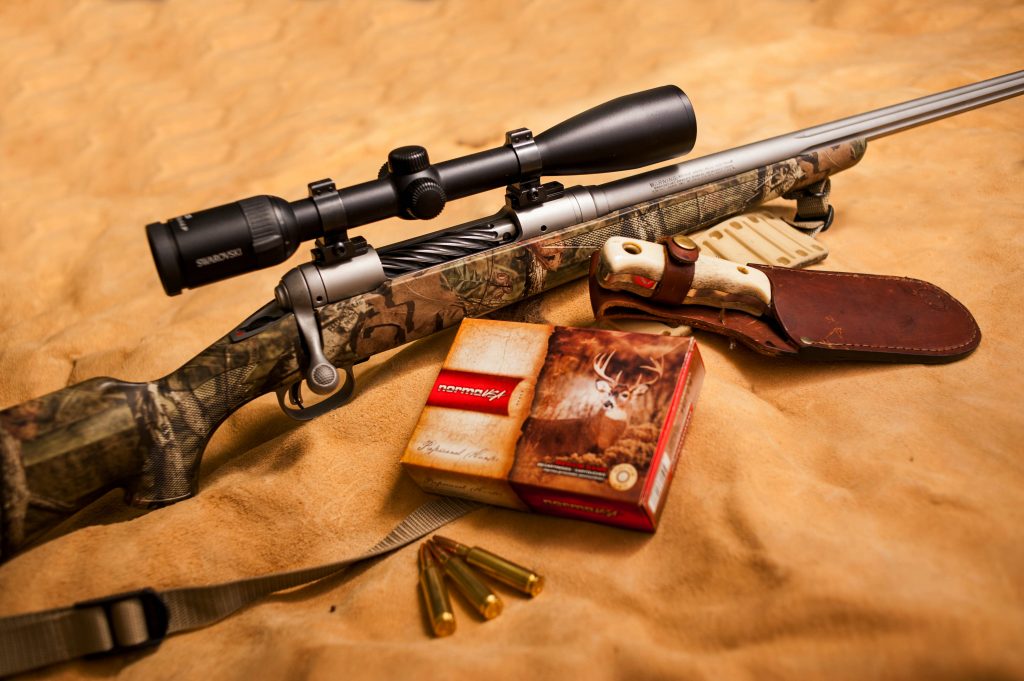The Savage Model 110

Action of Savage Model 110—Savage’s Model 110 spawned a long line of highly accurate and affordable rifles.
Among the American success stories in the firearms industry, Arthur Savage’s company ranks along with the best of them. The lever-action Model 99 is still synonymous with the Savage name, but the bolt-action Model 110 has probably been the Savage rifle that has been used by more shooters than any other model.
Designed in the late-1950s by Nicholas L. Brewer, it wasn’t released until the mid-1960s. This was a time of many new rifle releases, such as Sturm, Ruger & Company’s Model 77 and No. 1, as well as major model revisions to other long-popular firearms, such as the huge redesign experienced by the Winchester Model 70 during that era. The new-fangled Savage bolt-action rifle made its debut in turbulent times in the gun industry, yet hung on to show its value: The Model 110 has been produced continuously since its debut—that’s more than 50 years now—and during certain periods, it was the only centerfire rifle Savage produced.
In addition to having a very sound design, the Savage Model 110 has the privilege of being the first production rifle to feature a left-hand bolt. Even today, in a world where CNC machining is prevalent, left-handed rifles are still a rather limited commodity. While the Model 110 was and is the basis of Savage’s extensive bolt-action line, there are many different variations on the original. Today we have the Model 10, 11/111, 12/112, 14/114 and 16/116, all of which are the result of some modification to the 110, be it a different action length or finish appointment. No matter these changes, though, the famous action and barrel stay the same.
Not that long ago, Savage introduced the popular “Lady Hunter” line, featuring the 11/111 action, but with a stock that has been properly configured to better fit a woman’s longer neck and smaller hands. This allows a much more comfortable fit for a woman, and one that allow her to more easily acquire proper sight alignment and experience reduced felt recoil when compared to the cut-down traditional stock. My wife, Sue, uses a Savage Model 11 Lady Hunter in .308 Winchester, with great results.

Savage Lady Hunter in .308 Winchester 01 or 02—This is Savage’s Lady Hunter chambered in .308 Winchestr.
So just what is the Savage Model 110, and why is it special? Well, simply put, it is a push-feed, bolt-action, magazine rifle in a long-action designation (in that it will take cartridges having the length of a .30-06 Springfield or .270 Winchester). The 110 features an ambidextrous, three-position safety located on the tang at the top rear of the receiver. The “push-feed” designation refers to the design of the gun’s bolt face. With this design, the bolt does not control the cartridge until the action is fully closed. This is in contrast to the other type of rifle you’ll see referred to as “controlled round feed.” A rifle designed for controlled round feed locks the cartridge into the bolt face upon picking it up from the magazine.
Most Model 110s feature a detachable polymer magazine, and Savage’s magazine design feeds its cartridges into the action in a very efficient manner. The rifle’s bolt is easily removed for cleaning it and the bore. The way the bolt is held in the action has changed over the years. Older models have a nice little lever located on the right-hand side of the receiver that releases the bolt for removal. Today’s newer models have a release button located on the front end of the trigger guard.
While the early models of the Model 110 were solid sellers, Savage did the buying public a huge favor in the 21st century with the introduction of its AccuTrigger and, late the AccuStock. The Savage AccuStock, which comes factory equipped on some of the 110s, uses an aluminum framework block to secure the barreled action to the stock. This enhances the rifle’s accuracy, as it provides for consistent pressure along the action. The AccuTrigger is another neat Savage design. It uses a small blade in the center of the trigger that, in essence, allows the shooter to enjoy the accuracy benefits of a very light trigger without the danger of premature, accidental discharge that can be associated with too-light triggers of traditional design. It kind of works like the center blade in a Glock handgun trigger: If the blade is not depressed at the same time as the trigger itself, the rifle will not fire. In other words, you can bump the trigger side with a finger or knuckle, but unless you depress that blade at the same time, the gun will not discharge. I’ve used the AccuTrigger system on many rifles, and it is totally dependable.

Savage Model 10 in .223 Remington—A Savage Model 10, a sibling of the 110, this one chambered in .223 Remington.
Another feature of the Savage 110 and its closely related siblings that I have come to rely on is the accuracy and consistency of the barrels. Just about any 110 I’ve ever spent any time on the bench with has proven to be an excellent shooter. Savage uses a “button-rifling” method—a specific way of creating the rifling lands in the grooves on the inside of the barrel—and it’s a technique that has proven itself over the decades. Regardless the caliber, from the .223 Remington up to the .300 Remington Ultra Magnum and .338 Federal, they’ve all given more than satisfactory results through Savage’s button-rifled barrels. My own favorite is a Model 116 chambered in 6.5-284 Norma, a cartridge known for its accuracy potential and one only made better in the Savage platform.
Many of these little details are features that, years ago, you’d pay a gunsmith handsomely for once you found the basic rifle you liked. They are included in the Savage line, and I for one am glad they are.
